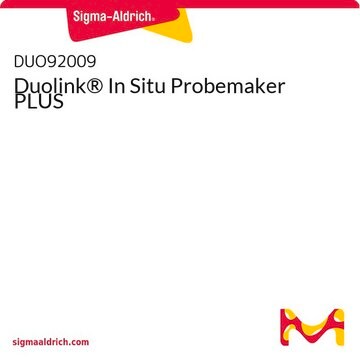Incubation in the pre-heated Heat Transfer Block increases staining efficiency and reproducibility between different plates and reduces plate edge effects. Other incubation methods can be utilized, but potentially to the detriment of reproducibility and increased plate edge effects.
DUO82065
Duolink® In Situ Microplate Heat Transfer Block
Selecione um tamanho
About This Item
Produtos recomendados
linha de produto
Duolink®
técnica(s)
proximity ligation assay: suitable
adequação
suitable for brightfield
suitable for fluorescence
temperatura de armazenamento
20-25°C
Categorias relacionadas
Descrição geral
Aplicação
This product can be applied to both the Duolink® In Situ Fluorescence Protocol and the Duolink® In Situ Brightfield Protocol depending on the detection reagents used.
Visit our Duolink® PLA Resource Center for information on how to run a Duolink® experiment, applications, troubleshooting, and more.
To perform a complete Duolink® PLA in situ experiment you will need two primary antibodies (PLA, IHC, ICC or IF validated) that recognize two target epitopes. Other necessary reagents include a pair of PLA probes from different species (one PLUS and one MINUS), detection reagents, wash buffers, and mounting medium. Note that the primary antibodies must come from the same species as the Duolink® PLA probes. Analysis is carried out using standard immunofluorescence assay equipment.HRP is also available for brightfield detection.
Duolink® In Situ Microplate Heat Transfer Block will increase staining efficiency and reproducibility between different plates and reduce edge effects when using Duolink® reagents in microtiter plates.
Keep the Heat Transfer Block preheated at 37°C and keep it in the 37°C incubator throughout the whole Duolink® In Situ protocol. Place the microtiter plate in the Heat Transfer Block during incubation steps.
Application Note
Two primary antibodies raised in different species are needed. Test your primary antibodies (IgG-class, mono- or polyclonal) in a standard immunofluorescence (IF), immunohistochemistry (IHC), or immunocytochemistry (ICC) assay to determine the optimal fixation, blocking, and titer conditions. Duolink® in situ reagents are suitable for use on fixed cells, cytospin cells, cells grown on slide, formalin-fixed, paraffin embedded (FFPE), or tissue (fresh or frozen). No minimum number of cells is required.
Linkage
Let us do the work for you, learn more about our Custom Service Program to accelerate your Duolink® projects
View full Duolink® product list
Características e benefícios
- No overexpression or genetic manipulation required
- High specificity (fewer false positives)
- Single molecule sensitivity due to rolling circle amplification
- Relative quantification possible
- No special equipment needed
- Quicker and simpler than FRET
- Increased accuracy compared to co-IP
- Publication-ready results
Nota de preparo
Informações legais
Escolha uma das versões mais recentes:
Certificados de análise (COA)
It looks like we've run into a problem, but you can still download Certificates of Analysis from our Documentos section.
Se precisar de ajuda, entre em contato Atendimento ao cliente
Já possui este produto?
Encontre a documentação dos produtos que você adquiriu recentemente na biblioteca de documentos.
Os clientes também visualizaram
Artigos
Things to consider for preparation, setup and execution of the Duolink® assay protocol
Support information including tips and tricks, frequently asked questions, and basic troubleshooting.
Conteúdo relacionado
Applications to detect, quantify and visualize protein-protein interactions, post-translational modifications and low expression protein detection using proximity ligation assay
-
Is it really mandatory to use a heat transfer block for PLA? What if I directly put my multi-well plate inside the incubator?
1 answer-
Helpful?
-
Active Filters
Nossa equipe de cientistas tem experiência em todas as áreas de pesquisa, incluindo Life Sciences, ciência de materiais, síntese química, cromatografia, química analítica e muitas outras.
Entre em contato com a assistência técnica













